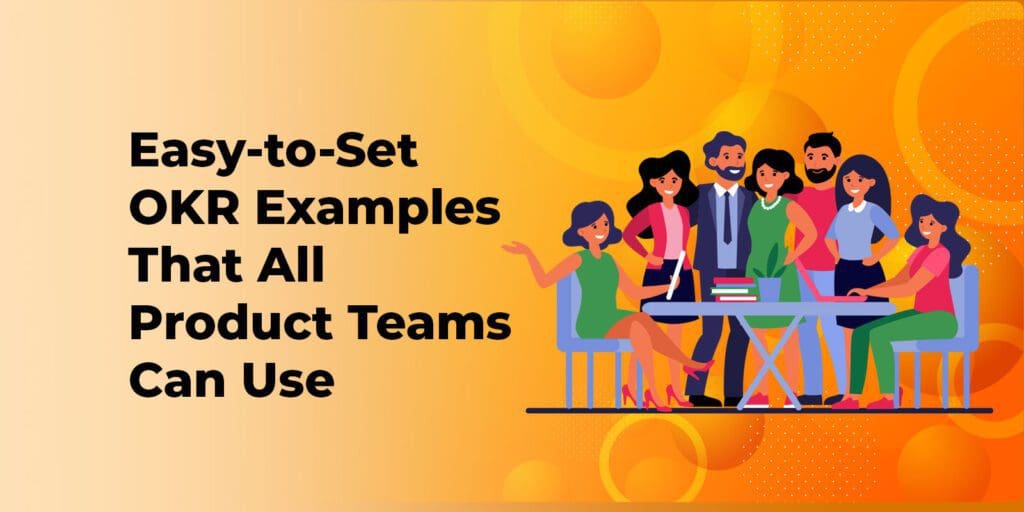Table of Contents
What are Product OKRs?
Product teams employ the OKR framework to establish challenging targets and monitor their progress. Product OKRs can be used to monitor a product launch’s efficiency, gauge the effect of a new feature, or improve the user experience as a whole.
Why is the Product Management Team Important?
Product teams often face demands, such as:
- Excessive number of projects to tackle
- The need to match changing customer demands
- Consistent and high-quality delivery of products.
- Meeting the company budget without compromising on quality
- Managing CI and CD
The product team members also combine their skill sets ranging from engineering, design, customer research and so on, to collate with the sales, operations, and marketing teams to ensure that the best quality products and services are delivered to clients.
Examples of Product OKRs.
The agility of the OKR framework helps alter the objectives and goals according to changing demands without hassle. Writing product OKRs can be quite challenging. However, if one thinks along the lines of “achieving X goal through X processes,” it becomes easier to translate these goals into successful results by following the necessary steps/ processes involved. By setting OKRs, the emphasis of the product management team will be on successful product launches and product development projects.
1. Identity product-market fit
Objective
Identity product-market fit
Key Result 1
Conduct 10 surveys to find the right market for the new product launch
Key Result 2
Identify 5 new Ideal Customer Profile (ICP) using Artificial Intelligence
Key Result 3
Employ 5 new employees to conduct interviews with the target audience
2. Hold a pre-launch party for the upcoming product release
Objective
Hold a pre-launch party for the upcoming product release
Key Result 1
Implement 10% more user testing in the pre-launch plan
Key Result 2
Reduce the number of bugs-per-feature metric in the prototype from 2.3 to 1.0
Key Result 3
Ensure at least 20 business engagements and deals after the launch party.
3. To Improve the delivery speed of the new products for a better customer satisfaction rate
Objective
Improve the delivery speed of the new products for a better customer satisfaction rate
Key Result 1
Boost the sprint team velocity from 20 to 50 points
Key Result 2:
Launch the product by the end of the quarter and achieve 2000 downloads within the first month.
Key Result 3:
Increase the number of satisfied customers by 30%
4. Conduct a successful product launch for Product 3.0 through better website traffic
Objective
Conduct a successful product launch for Product 3.0 through better website traffic
Key Result 1:
Increase the sign-up to trial Conversion Rate from 10% to 40% to acquire more customers
Key Result 2:
Use target marketing campaigns to increase website traffic by 20%
Key Result 3:
Improve customer satisfaction rate from 15 to 30


The pirate metric of the AARRR (Acquisition, Activation, Retention, Referral, Revenue) can help businesses and startups thrive at every stage. It refers to a set of metrics companies can use to improve their customer journey — and therefore grow the business.
For instance, in the first Acquisition stage, the OKR can be set in the following manner:
5. To Increase the number of new users who sign up for the product
Objective:
Increase the number of new users who sign up for the product
Key Result 1:
Improve customer journey by providing a 10% discount for new members
Key Result 2:
Ensure 2% growth at every stage of their sign-up to trial conversion
Key Result 3:
Improve the number of impressions on social media by 10%
In the Revenue phase, the focus is on increasing the revenue from the existing userbase
6. To Increase revenue from existing users
Objective:
Increase revenue from existing users
Key Result 1:
Implement performance metrics for the team to ensure they communicate with clients on time
Key Result 2:
Increase unit-test coverage from 40% to 50% to ensure customer satisfaction
Key Result 3:
Raise the average revenue per user per month by 30%.
7. To Create a cohesive product team for successful product launches
Objective:
Create a cohesive product team for successful product launches
Key Result 1:
Host 10 knowledge-sharing sessions by team
Key Result 2:
provide regular feedback to improve product team learning
Key Result 3:
Host off-site team meetings to celebrate new launches
8. To Identify the difference between the users and the non-users opinions of our products
Objective:
Identify the difference between the users and the non-users opinions of our products
Key Result 1:
Interview 25 key accounts
Key Result 2:
Increase current user testing coverage from 40 to 50
Key Result 3:
Interview 30 non-users
9. To Increase profit per customer
Objective:
Increase profit per customer
Key result 1:
Enhance lifetime value (LTV) from $300 to $1000
Key Result 2:
Decrease churn by 3%
Key Result 3:
Increase net retention by 5%
Thus, the product management team can focus on the most crucial tasks and use the OKR methodology as a straightforward and quantifiable way of measuring progress.
By using, product teams can align with the larger business goals, ensure transparency and measure their success.
Sign up for free to execute your goal-planning strategies starting today!
FAQs
How can the product team’s OKR be set up?
Product teams can ensure receive the most value possible by aligning and constructing cross-functional OKRs amongst departments.



